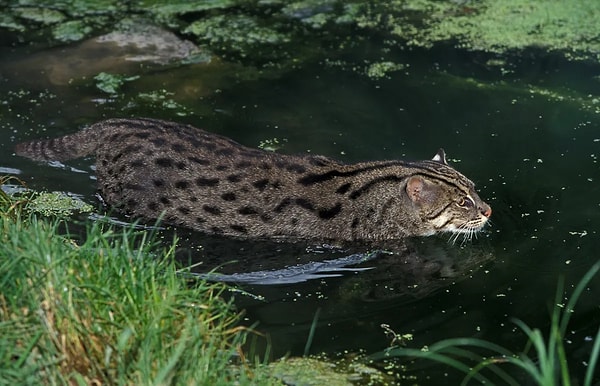Meet The World's Most Aquatic Feline That Doesn't Fear Water
While most cats around the world wouldn't even dare to approach water, fishing cats lead a lifestyle that is the complete opposite. Rivers, swamps, and mangrove forests are virtually their natural playgrounds. Their robust bodies, water-friendly fur, and swimming claws set them apart from other cats. Moreover, they are known for diving into the water when hunting.
Let's take a closer look at these extraordinary felines...
Fisherman cats distinguish themselves completely from other cats with their physical structures adapted to water.

Recognized for their stout bodies, short legs, and stubby tails which grant them balanced movements, fishing cats are slightly larger than the average house cat. The semi-webbed structure on their front paws facilitates swimming and maneuvering in water. This anatomical adaptation provides them with an incredible advantage in wetland areas.
Their fur structure is also noteworthy. Their double-layered, water-resistant coats not only keep them warm but also aid in quick drying once they emerge from water. While the long hairs on the top layer accentuate their patterns, the dense layer underneath effectively insulates the cat.
Fishing cats reside in the wetland regions of South and Southeast Asia, with their feeding habits tailored to these habitats.

Sri Lanka, Bangladesh, the West Bengal region of India, and the Terai Duar belt of Nepal are recognized as some of the most robust habitats for this species. Riverbanks, swamp forests, and mangroves provide ideal territories for these cats, offering both shelter and ample hunting grounds.
Upon examining their feeding habits, it's observed that fish make up approximately 75% of their diet. However, as opportunistic hunters, they also feed on crustaceans, birds, frogs, small reptiles, and rodents.
During the rainy seasons, when intense monsoon rains make fishing more challenging, they are known to climb high trees and target water bird nests, demonstrating their adaptability in the face of changing circumstances.
The species is considered endangered due to both the loss of its natural habitat and conflicts with humans.

The destruction of wetlands due to agriculture, settlement, and industry is shrinking the habitats of fishing cats. The species, listed as 'vulnerable' on the IUCN Red List, is reported to be declining in population. Moreover, their encounters with communities in their habitats who rely on fishing and bird hunting are leading to major conflicts.
Keşfet ile ziyaret ettiğin tüm kategorileri tek akışta gör!

Send Comment